Nuclear Semiotics
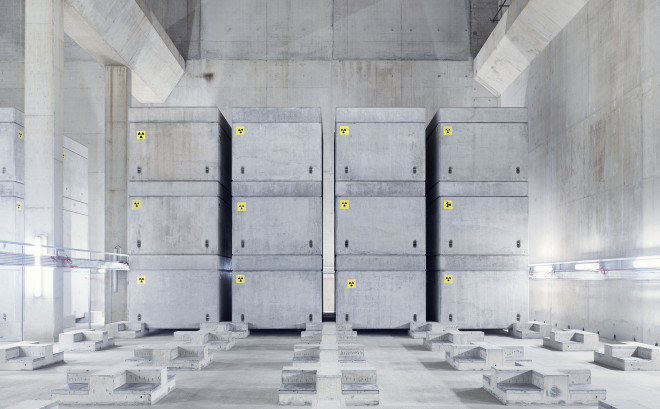
This research was conducted as part of the second year of my residency at Sorbonne University. During this period, I exchanged with professor-researchers, and students whose expertise extended from scientific fields such as nuclear physics to literary and historical studies like the philosophy of technology. The study's original subject was to envisage the legacy of the nuclear world through its future artifacts. It inevitably fell into the field of nuclear semiotics as an effort to communicate to future generations the dangerosity of our nuclear waste repositories.
I did not intend, nor did I find a viable solution to this millennial problem. Instead I took it as an exercise to better understand the various forces at play. Throughout this process, I also met with individuals who serve on national councils that directly address this issue. To my surprise, this particular question is not a primary focus within the nuclear sector. It is often considered a secondary concern, with most research focused on short-term memory (the next hundred years). Anything beyond that is often relegated to be a romantic problematic, sometimes used as a communication tool to entice public acceptance of nuclear culture.
Nuclear Waste in the World
As of 2024, there are approximately 440 active nuclear reactors worldwide1. Each reactor produces about 25-30 tons of high-level radioactive waste (HLW) annually2. This amounts to between 11,000 and 13,200 tons of HLW each year, so where is it disposed of ?
Before 1993, both military and energy industries disposed of their radioactive waste directly into the ocean3. This practice was later banned, inviting the nuclear industry to explore alternative solutions. Among these, large pools, comparable to Olympic stadiums, were created to store spent fuel under the protective barrier of water. More recently, underground laboratories have been researching long-term deep geological storage solutions. The first of these, Onkalo in Finland, will soon be operational. It is designed to securely store waste for up to 100,000 years.
It's safe to say that our nuclear waste will outlast us. Many artists have compared it to prehistoric cave paintings, a legacy we will leave for future generations. This raises an important question: how do we warn humans thousands of years from now about the presence and danger of these radioactive waste sites scattered around the world ? Essentially, this has been the focus of my research.
Map of Nuclear Sites
In order to get a better idea of nuclear culture, I decided to draw a map of all the places with a past, present or future radioactive activity. Created through open-source investigation, it includes a large sample of locations, that of deep geological storage, ocean dumping sites, nuclear accidents, military nuclear testing, and underground research laboratories. The aim of this list is not to provide an exhaustive account of all radioactive matter, but rather to offer a broader perspective on the legacy of nuclear culture.
By hovering over the colour coded sites, you'll understand the aggregates better and get an intuition about the geopolitical dimension of nuclear.
Semiotics for a Distant Future
Nuclear semiotics refers to the study and development of communication methods designed to convey the dangers of radioactive waste to future generations. Given that nuclear waste remains hazardous for tens of thousands of years, traditional communication methods (such as language and symbols) may not be comprehensible to future societies. The described field explores how communication can transcend linguistic, cultural, and temporal barriers, focusing on the resilience of both the message and the medium that carries it. To understand this better let's have a look at some historical proposals that address this problem.
1. Information Center at the Waste Isolation Pilot Plant (WIPP)
The Waste Isolation Pilot Plant is a repository for radioactive waste licensed to store radioactive waste in New Mexico, USA for 10,000 years. Since 1983 the department of energy has been working with linguists, archaeologists, anthropologists, materials scientists, science fiction writers, and futurists to come up with a warning system5. Together they have come up with the idea of a roofless information centre placed directly above the storage.
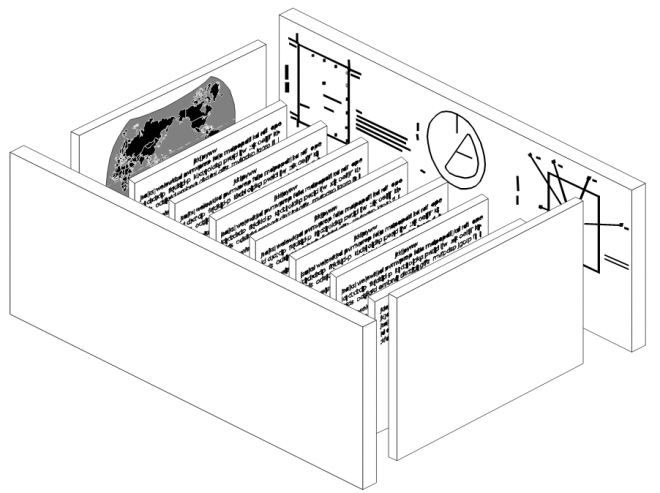
The warning and information would be etched into the granite slabs, recorded in the six official languages of the United Nations, with additional space for translation into future languages. They have also considered the use of pictograms, such as stick figures and the iconic The Scream from Edvard Munch's painting. The full details about the plant would however not be stored on site; instead they would be dispatched to archives and libraries around the world6.
2. Hostile Architecture
The 1993 Sandia report explored designs for physical markers that can be seen as a form of hostile architecture7. The goal of these structures is to convey a sense of danger and unease, evoking feelings of bodily harm and creating the impression of a shunned land. Among the proposed designs were landscapes of spikes, which effectively communicate an authentic sense of danger. There were also more subtle approaches, such as the "Forbidding Blocks," a concept similar to the Holocaust Memorial in Berlin. This design features a network of hundreds of stone blocks arranged in an irregular square grid, creating an area that feels disorienting and unusable for activities like farming or any other practical purpose.
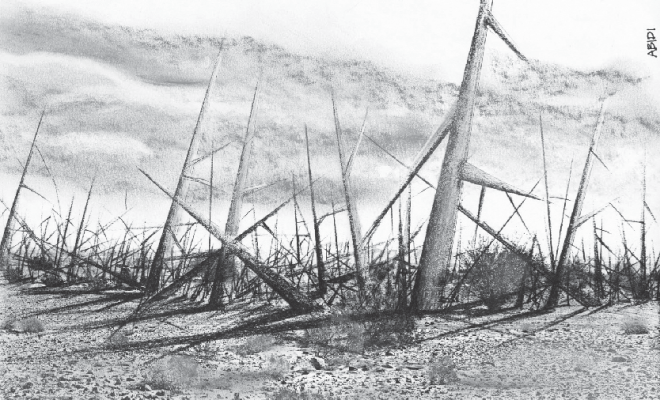
3. Ray Cats
The Human Interference Task Force, established in 1981 by the United States Department of Energy, suggested reconsidering oral transmission as a means of preserving warnings for future generations. Various proposals emerged, including the idea of repurposing religion to create new annual rites or establishing an "atomic priesthood." However, one proposal stands out for its apparent absurdity: the idea put forth by philosophers Françoise Bastide and Paolo Fabbri to use cats as messengers since they are already deeply embedded in our mythology and history. As such they would bio-engineer cats to glow in the presence of radioactivity, thereby warning their owners of nearby danger8. Furthermore they proposed a lore around the glowing cats, to be passed on through music, poetry, proverbs and myths.
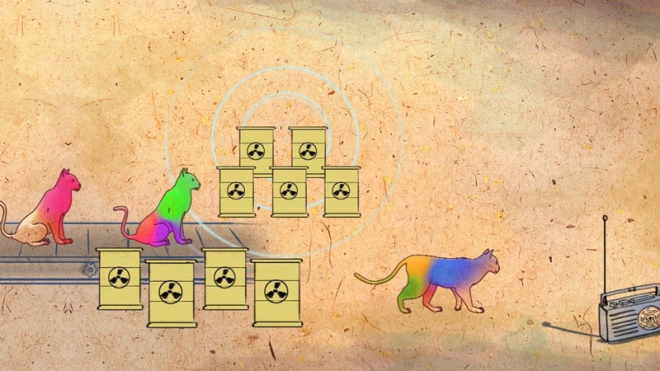
The idea has since permeated popular culture. It has been featured in newspaper articles, inspired the award-winning film "The Ray Cat Solution" by Benjamin Huguet, and even influenced music, such as the album "10,000-Year Earworm to Discourage Settlement Near Nuclear Waste Repositories" by Emperor X, which includes a pop song about the ray cats. While nuclear institutions around the world do not endorse this idea as a viable solution, they benefit from the public's engagement, as it contributes to a broader acceptance of nuclear energy as a whole.
A Matter of Medium
The problem can be broken down into two distinct components: the medium and the message. For the medium, it is critical to find a material that can remain intact over vast periods of time, possibly for as long as a million years. This material must also be universally recognisable to future humans. Architectural solutions embody these criteria well, using durable construction materials that are arranged into recognisable artificial structures, ensuring the medium remains relevant and resistant to both material degradation and cultural erosion over time.
While materials like ceramics, glass composites, diamonds, and basalt have potential for long-term preservation, I chose a different axis. Inspired from archaeological discoveries, I found that not only minerals but also organic molecules could attain the level of resilience I was looking for. For example, DNA has been recovered from a mammoth tooth that lived 1.2 million years ago9. I find it fascinating that we can still read this DNA and extract meaning from it. This suggests that if biologists exist in the distant future, DNA could serve as a viable medium to communicate with them. As the molecule of life, DNA possesses a universality, not necessarily for writing messages, but as a substance that forms the basis of "us" potentially inviting intrigue and efforts to decode it.
For this project, I collaborated with Sorbonne's biology department to explore DNA based information storage technologies. Our approach didn't involve rewriting genetic code for biological processes but rather using the nitrogen bases of DNA as encoding characters for encoding information in cold storage. This practice has recently gained popularity in large-scale archival projects, as in theory a single strand of DNA can store up to 215 petabytes.
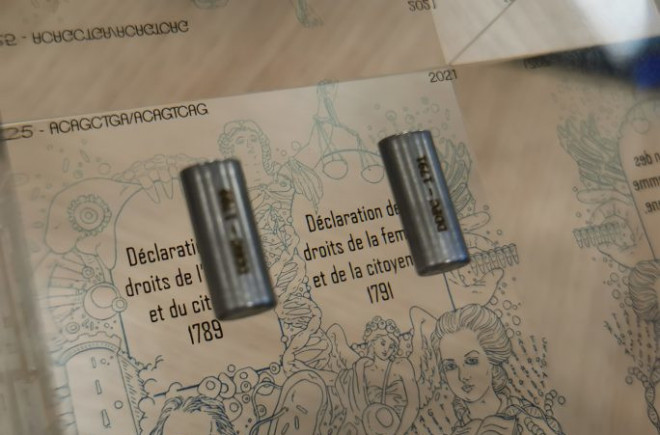
Decoding a strand of DNA might seem complex, but the assumption is that any human society will, over time, develop a foundational understanding of biology that leads to the discovery and decoding of their own genetics. Therefore, any technologically advanced human civilisation should eventually be able to decode DNA, whether it’s biological or artificially encoded. A further consideration would be to determine the strategic placement of these DNA capsules. My initial thought was to store them in libraries, archives, and museums.
A Matter of Message
The laboratory I collaborated with gave me the opportunity to encode 1 kilobyte of data into multiple strands of DNA. The next step was deciding what message to encode. Given the small amount of data available, we realised that words alone wouldn’t be sufficient. In the end, we chose to encode the normalised geographic coordinates (latitude and longitude) of a selected list of historical nuclear sites, without adding explicit warnings. Our reasoning was that if one of these sites is uncovered in the future and its dangers are recognised, future generations could then access the precise coordinates of other nuclear waste sites, potentially preventing further catastrophes.
Since this project was more of a case study and artistic one, we also chose to include controversial sites; locations that are only mildly radioactive today but carry significant historical and political tension, particularly in relation to France’s nuclear testing sites in Algeria and French Polynesia. Including these sites serves as an homage to countries that endured colonial regimes, acknowledging the ongoing sense of injustice felt by people in these regions who continue to live with the scars of their ancestors history.
List of Selected Sites
| Latitude | Longitude | Country | Place | Type |
|---|---|---|---|---|
| 52.216667 | 11.099722 | Germany | Morlesben | Geological Storage |
| 52.143889 | 10.642222 | Germany | Schacht Asse II | Geological Storage |
| 61.236944 | 21.440833 | Finland | Olkiluoto | Geological Storage |
| 32.371667 | -103.793611 | United-States | Carslbad | Geological Storage |
| 60.372222 | 26.347222 | Finland | Loviisa | Geological Storage |
| 35.727396 | 129.481044 | South Korea | Gyeong-Ju, Wolseong | Geological Storage |
| 46.218942 | 18.61078 | Hungary | Bátaapáti | Geological Storage |
| 50.375273 | 12.940155 | Czechia | Bratrství, Jachymov | Geological Storage |
| 50.544383 | 14.105825 | Czechia | Richard, Litoměřice | Geological Storage |
| 60.407769 | 18.207755 | Sweden | Forsmark | Geological Storage |
| 60.400292 | 18.182343 | Sweden | Forsmark | Geological Storage |
| 61.235148 | 21.481852 | Finland | Olkiluoto | Geological Storage |
| 48.48698 | 5.355602 | France | Bure | Geological Storage |
| 52.199444 | 10.387778 | Germany | Schacht Konrad | Geological Storage |
| 51.219043 | 5.093483 | Belgium | Mole | Underground Research Laboratory |
| 56.250211 | 93.53636 | Russia | Krasnoyarsk | Underground Research Laboratory |
| 47.578572 | 8.521575 | Switzerland | Nördlich Lägern | Underground Research Laboratory |
| 45.043544 | 141.860712 | Japan | Horonobe | Underground Research Laboratory |
| 35.408309 | 137.233445 | Japan | Mizunami | Underground Research Laboratory |
| 36.421063 | 127.374651 | South Korea | Deokjin-Dong | Underground Research Laboratory |
| 57.433062 | 16.659971 | Sweden | Äspö | Underground Research Laboratory |
| 48.611305 | -13.480328 | United Kingdom | Atlantic Sea | Underwater Deposit |
| 47.117752 | -16.499322 | United Kingdom | Atlantic Sea | Underwater Deposit |
| 47.54692 | -17.072878 | United Kingdom | Atlantic Sea | Underwater Deposit |
| 38.529108 | -72.067981 | United States | North Atlantic | Underwater Deposit |
| 74.474832 | 59.653814 | Soviet Union | Kara Sea | Underwater Deposit |
| 71.924519 | 55.853849 | Soviet Union | Kara Sea | Underwater Deposit |
| 40.075564 | 130.264912 | Soviet Union | Sea of Japan | Underwater Deposit |
| 55.713358 | 60.846811 | Russia | Kyshtym | Nuclear Accident |
| 51.38926 | 30.098728 | Ukraine | Tchernobyl | Nuclear Accident |
| 37.421391 | 141.032567 | Japan | Fukushima | Nuclear Accident |
| 49.979494 | 78.06746 | Kazakhstan | Semipalatinsk | Nuclear Testing Site |
| 11.590745 | 165.505309 | United States | Bikini Atoll | Nuclear Testing Site |
| 11.55639 | 162.296953 | United States | Enewetak Atoll | Nuclear Testing Site |
| 37.031318 | -116.212022 | United States | Nevada | Nuclear Testing Site |
| 73.201885 | 54.716479 | Russia | Novaya Zemlya | Nuclear Testing Site |
| 41.372166 | 88.300594 | China | Lop Nur | Nuclear Testing Site |
| 27.09023 | 71.740603 | India | Pokhran | Nuclear Testing Site |
| -21.829667 | -138.869725 | France | Moruroa Atoll | Nuclear Testing Site |
| -22.230953 | -138.743046 | France | Fangataufa Atoll | Nuclear Testing Site |
| 24.043713 | 5.042987 | France | In Ekker, Algeria | Nuclear Testing Site |
| 26.312623 | -0.075739 | France | Reggane, Algeria | Nuclear Testing Site |
| 41.285795 | 129.106462 | North Korea | Punggye-Ri | Nuclear Testing Site |
The list of coordinates was then transformed into a binary string, which was subsequently encoded into DNA sequences by converting the binary data (0s and 1s) into sequences of the four nitrogenous bases found in DNA: adenine (A), cytosine (C), guanine (G), and thymine (T).
Technology and Tectonics
There are several reasons why both this medium and that message are both imperfect. One of the most apparent issues is that the geo-coordinate system is not unique, and over geological timescales, tectonic plate movements will alter the configuration of the Earth's surface. An accurate coordinate today may become imprecise in the distant future. However, the most unexpected flaw in the proposal is that the laboratory I worked with used a proprietary algorithm to encode the data, making it exceedingly difficult to decode in cryptographic terms. This decision was influenced by the fact that, during the residency, the laboratory shifted its research focus as it transitioned into a startup called BioMemory, which suddenly prioritised protecting its research and intellectual property.
I was initially rather disappointed by this change. However, it also seems fitting, in an ironic way, that initiatives like these (whether artistic or practical) designed to address societal issues often become shaped by the prevailing neoliberal structures. In this case, proprietary technology and commercial interests took precedence, limiting the potential of the underlying research.
An Impossible Fossil
The final work, Fossile Impossible, took the form of a sculpture and was exhibited at the eponymous exhibition, alongside the list of coordinates mentioned earlier. It was seen as a subtle reference to the movie Jurassic Park, where in the opening scene, a scientist shows dinosaur DNA preserved in amber. In this case, however, the DNA containing the locations of the selected nuclear sites was trapped in a block of epoxy resin.
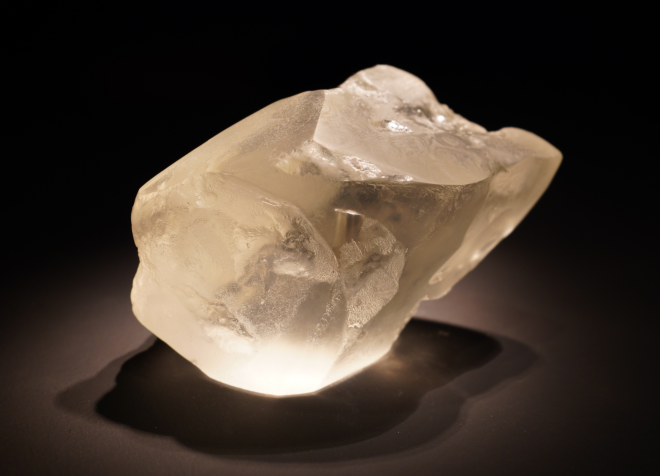
By revolving around the sculpture and looking closely you can spot the capsule, a bullet-shaped container holding the vitrified DNA, suspended in the centre of the transparent rock. Since we had excess DNA, we made ten copies each with their own capsule container. The nine others are still in the studio, waiting to be dispatched around the world, or perhaps I'll turn two into a pair of earrings.
Credits
Exhibited during the exhibition "Fossiles Impossibles"
from the 3rd to the 12th of May 2024
@ Theatre de la Ville in Paris, France
Funded by Sorbonne University
Curated by Justine Jean (DRSCS)
(Directorate of Science, Culture, and Society Relations)
Kaspar Ravel - Artist
Daniel Santos-Sales - Archaeology and Programming Intern
BioMemory SAS - DNA writting
Following the exhibition, we were approached by the French national radioactive waste management agency (ANDRA) to participate in work sessions with a multidisciplinary group. The goal is to develop an iconography that conveys the levels of danger associated with radioactive waste in France. This work is ongoing and will continue until 2025.